Vehicle leaking fluid after hitting garbage can at Williams Park
A vehicle has hit a garbage can behind the ball field at Williams Park and is leaking fluid.
No injuries.
City Fire dispatched.
A vehicle has hit a garbage can behind the ball field at Williams Park and is leaking fluid.
No injuries.
City Fire dispatched.
Press Release
Batavia, NY – Seize the day with a guided kayak tour of DeWitt Lake! Join us Saturdays July 9th and 16th to explore the lake by water and discover a new world. Each day has 2 sessions. Session 1 takes place from 10:00 am to 12:00 pm, Session 2 takes place from 1:00 pm to 3:00 pm.
Meet at the boat launch at DeWitt Recreation Area. No experience needed, a beginner kayaking lesson is provided! Kayak rentals with life vests are provided or you may bring your own. Rentals are available for ages 12 and up, no tandems for rent.
Guided tour fee is $15/person without rental or $25/person with kayak rental per session. Pre-registration is required, call 585-344-1122!
For more information visit our website at http://www.co.genesee.ny.us/departments/parks/, or
contact Shannon Lyaski at Shannon.Lyaski@co.genesee.ny.us or (585) 344-1122.
Press Release
The hard work and dedication of the team at Community Action of Orleans and Genesee was recognized this week by the New York State Department of State.
In a certificate of recognition issued as part of Community Action Month, Secretary of State Robert Rodriguez wrote “Today we recognize and express our gratitude to Community Action of Orleans and Genesee, Inc, under the leadership of Renee Hungerford, Executive Director, for their extraordinary efforts and service to the State of New York and their contributions to the ongoing efforts and service to the State of New York and their contributions to the ongoing efforts to strengthen and enhance the success of the community action network.”
Renee joined Community Action of Orleans and Genesee in 2020. Since taking the reins as CEO, she has worked tirelessly to identify the needs of Orleans County and Genesee residents and pave to new paths that meet those needs close to home.
Most recently, Hungerford has been the driving force that launched Community Action’s recently announced “Axis of Care” program, which will increase access to healthcare for homeless and housing insecure families across the county.
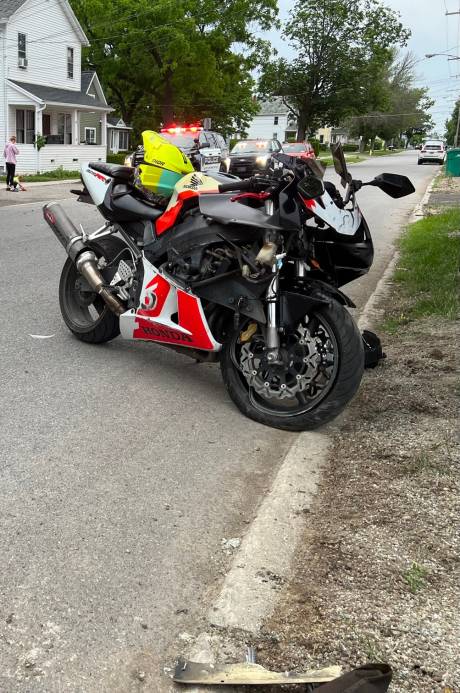
Two motorcycles are reported down in the road at Liberty Street and Sumner Street, Batavia.
Unknown injuries.
City Fire and Mercy EMS dispatched.
UPDATE 8:15 p.m.: Two motorcyclists collided, no other vehicles involved. Both drivers were seen walking around the scene. Mercy EMS has left the scene without transporting anyone. The accident is under investigation and Batavia City Police will provide an update later.
UPDATE 10:30 p.m.: The investigation so far indicates that the two motorcycles were southbound on Liberty, speed unknown, when the front motorcycle slowed suddenly and the driver of the trailing bike (pictured above) did not see the front bike slowing in time to slow himself down and he rear-ended the first bike. The first rider was transported by a private vehicle to an unknown hospital for treatment/evaluation. The second rider was uninjured. No citations were issued. Sgt. Mitchell Cowen said, perhaps coincidentally, he had been dispatched minutes before the crash was reported to East Main Street to investigate a complaint of two motorcycles driving at a high speed and recklessly on East Main Street. A firefighter on scene had also said two motorcycles had been speeding on Evans Street shortly before the crash. There is no evidence, however, that the two bikes involved in the crash were the same bikes reported elsewhere in the city earlier.

Eli Fish is hosting our first annual Carnival and we're throwing it for the adults in the area that just want to have fun and not worry about bringing the kids for one night. Face paint? Check. Magicians? Check. Live music? Check. Dunk tank? Oh you know it. We'll have beer pong, craft beer, axe throwing, and so much more! So come on down and take a break with us this Saturday from 4 pm - 10 pm • Jackson Square, Batavia! Click here for more information and purchase tickets.

"Brad Pitt" (not his real name) has, in the space of a month, gone from a fearful, emaciated, feces-covered canine to a healthy, sweet-tempered, friendly, sweetheart of a dog while in the care of the county's Animal Control officers and Volunteers for Animals.
"Pitt" was seemingly abandoned by his owners in Apt. 60, 337 Bank St., Batavia. He was found on May 10 in a cage inside the apartment without food, covered in his own fecal matter, and skinny and weak.
A female Pitbull was found in the same apartment, also in a cage, also in poor health -- so poor that by the time a veterinarian determined what to do for her, the most humane option was to euthanize her.
The two people who allegedly abandoned the dogs are Andrew A. Searight, 35, and Jerrtonia A. Scarbrough, 24. Both have been charged with felony aggravated cruelty to animals.
According to court documents, a maintenance worker at Walden Estates was aware of the dogs and the owners and also believed the couple had stopped paying rent sometime prior to May. He and a neighbor had observed the residents moving out of the apartment some days to a week or so prior to May 10. On that date, the worker observed trash piled up outside the apartment. He spoke to a neighbor who said he hadn't seen the occupants for a week or two.
The female dog had given birth some weeks prior, according to the neighbor, and he had witnessed, he said, the residents removing the puppies and a TV.
The worker asked if the adult dogs were still inside, and the neighbor said he believed they were still in the apartment.
The worker looked into the apartment and saw one of the dogs in a cage.
Concerned about the health and safety of the dogs, both the property manager and the neighbor entered the apartment through an unlocked door and found two Pitbulls locked in cages, unfed, and covered in "shit," as the neighbor said in his statements.
"The black dog looked terrified and almost dead," the neighbor wrote. "The other dog looked terrified, shocked, and couldn't even stand, so we had to pull him from the crate. He had no strength at all."
He contacted the property manager and asked her to call the police. Officer Peter Flannigan and Sarah Fountain, a county animal control officer, responded.
Fountain wrote that when she arrived she found the dogs in the condition described by the witnesses and that the black dog, the female dog, was cold to the touch.
Both dogs were assisted to the animal control vehicle, with the female dog carried on a stretcher.
A normal dog's temperature is between 100 and 102 degrees. The female dog's temperature was 93.3, the veterinarian told Fountain.
The dog "had no reserves and, basically, her body was shutting down," Fountain reports the vet telling her. She was down to 20.4 pounds and should have weighed at least 40 pounds.
The vet did not expect the female dog to recover so it was euthanized.
The male Pitbull -- who has acquired the nickname "Brad Pitt" while at the shelter -- has been put on a thrice-a-day feeding plan and was up to 45.9 pounds by the time Fountain wrote her report for investigators. She could not discuss his current condition today since there is still a criminal case pending.
Searight was originally scheduled for an appearance in City Court yesterday, but the case has been moved to 1:30 p.m. June 21.
Legally, Searight and Scarbrough still own the dog. Typically in animal abuse cases, the defendants are asked during the proceedings to surrender the dogs to Animal Control, at which point, the animal can be put up for adoption.
Fountain also reported finding a cockatiel in the apartment. She couldn't assess its health condition and The Batavian doesn't have information on its status.


There are four vehicles involved in an accident at West Main Street and River Street, Batavia.
All occupants are out of the vehicles and walking around, according to a first responder.
City Fire and Mercy EMS dispatched.
UPDATE 5:45 p.m.: Two more ambulances requested to the scene to evaluate patients.

Batavia PD is looking for a person of interest in association with the theft of benches from a local business.
The name of the business nor location were released by the department.
The person of interest and vehicle associated with that person are shown in the photos.
The bottom photo is of a bench identical to the ones that were stolen.
Anyone with information is asked to contact Officer Nicole McGinnis at (585) 345-6350 or the Batavia Police Department's confidential tip line at 585-345-6370.




A 37-year-old Batavia woman admitted in Federal Court today to wire fraud in a case that involves her possession of unemployment benefit cards in the names of other people.
Danielle Tooley faces up to 30 years in Federal prison and a $1 million fine when she is sentenced in August.
A state trooper uncovered the fraud during a routine traffic stop in Bergen on Nov. 24 in which he first discovered evidence of crack cocaine and then during a search of the vehicle found six NYS unemployment benefit cards in the vehicle's center console.
According to the trooper, he observed a crack pipe with white residue in the vehicle. Tooley admitted at the time that she had crack cocaine in the vehicle's center console. As he prepared the vehicle to be towed, he recovered the cards made out to individuals other than Tooley. He turned the cards over to the U.S. Department of Labor.
Federal authorities investigated and found that Tooley had withdrawn money from bank accounts associated with the benefit cards.
Prosecutors say that Tooley used the COVID-19 relief program to perpetuate her fraud.
The plea is the result of an investigation by the U.S. Department of Labor, Office of Inspector General, Office of Investigations – Labor Racketeering and Fraud, New York Region, under the direction of Special Agent-in-Charge Jonathan Mellone; the Department of Homeland Security, Office of Inspector General, under the direction of Acting Special Agent-in-Charge Todd Allen; the U.S. Secret Service, under the direction of Special Agent-in-Charge Jeffrey Burr; the Social Security Administration, Office of Inspector General, under the direction of Special Agent-in-Charge Sharon B. MacDermott; and the New York State Police, under the direction of Major Barry Chase.
Sentencing is scheduled for August 17, 2022, at 3:30 p.m. before Judge Wolford.

What began as an innocent conversation at a parent meeting has turned into a new role and title for Tina Bak of Oakfield.
During the meeting that also included Susan Zeliff, who with her husband owns and operates The Goose and founded Warrior House, Bak learned that the wheels were not yet in motion for an upcoming benefit for the nonprofit.
“We were just chit chatting at the last PTO meeting that I came to — she has let us use the Goose … and she told me that she wanted to have this benefit during garage sale weekend in June, and hasn't started planning it yet. We got together and met like a couple days later, and I started calling around for donations,” Bak said during an interview with The Batavian. “She's like, ‘holy smokes, you're on a roll.’ She goes, you're not just my volunteer, you're the fundraiser coordinator.”
Bak has had great success in getting donations, with the total being more than 200 items for an upcoming basket raffle. Generous businesses have wanted to be part of the fundraising effort for this cause, and Bak has collected goods from “Buffalo to Rochester, and everywhere in between,” she said.
The event is an open house and basket raffle for Warrior House, and runs from 9 a.m. to 3 p.m. Saturday at The Goose, 33 South Main St., Oakfield.
Warrior House is a concept as much as a location. In fact, it stemmed from a conversation by the Zeliff family when deciding what to do with a farmhouse on a piece of property the family purchased. The original mission and location have changed and expanded, moving from Orleans to Genesee County and, in addition to supporting men and women veterans, it includes a food pantry, community center, meeting room, seasonal hunts and school supply, toy and clothing drives.
As of this past fall, the Zeliffs purchased the former Camp Hough property at Silver Lake, so they could also provide additional camping opportunities for veterans and their families. (See related article here.)
Proceeds from the basket and 50/50 raffles will help offset costs of community events such as paint nights, monthly community meals and arts and crafts activities for adults and children, all free of charge to the public.
“It’s been kind of fun, it’s just an exciting thing to see what we've secured. This is going to be a huge raffle. We've got something for everyone,” Bak said. “We've got dinner, and restaurants and entertainment, and just fun gift cards … we’ve got something for literally everyone.”
Golf packages worth up to $425, Maid of the Mist tickets, wine tours, an exercise bike, pizza for a year from Santino’s, a $250 Target gift card, Jim Kelly autographed football, $100 cash, NFL and NHL signed memorabilia, a GLOW YMCA family membership for a year in Batavia are just some of the raffle items.
Or maybe Stokoe Farms admission, Oliver’s, Alex’s Place and Eli Fish Brewing Company gift cards, a Valle Jewelers bracelet, a Miss Buffalo cruise, a Mary Kay beauty basket and a Batavia Downs Gaming stay and play package are more enticing.
For higher value items, tickets are $1 each, $5 for six or $10 for 12, and remaining basket raffle items are $5 for a sheet of 26 tickets or $10 for three sheets. A 50/50 raffle will be $1 per ticket, $5 for six tickets or $10 for 12.
The Goose has become the central hub for many activities and events, and it has been getting some major touch-ups this past year. Some grant monies have helped to pay for renovations, including a commercial kitchen still in progress, Bak said.
The site has been topped with a new roof, while inside renovation progress is near completion. The food pantry, which has its own location within the building, and the Community Room, are still in progress, the bathrooms are finished and a commercial kitchen is nearing the finish line. Another addition, probably for next summer, will be a Farmers Market location within the building.
The food pantry helps out 50 to 60 families each month, and a Christmastime toy and clothing drive helped out untold numbers of folks during that season. A common phrase nowadays is food insecurity, which simply means that folks are struggling to make ends meet, pay their bills and also put a meal on the table for the family.
It’s all “pretty cool,” Bak said.
“We hope to see it being used by the community for events, dinners, activities, and by groups to who need a space for meetings or other activities,” Bak said. “We are excited to have this project come to fruition. We would not be where we are now without the donations from our generous sponsors."
For more information, email thegoose33@aol.com or call (315) 730-0606. Tickets may be purchased during the open house or online with Venmo or PayPal. When ordering online, indicate if the purchase is for the 50/50 or basket raffle. A gallery of baskets are online for viewing at The Goose on Facebook. For online orders, pay to Susan Zeliff and @warriorhousewny
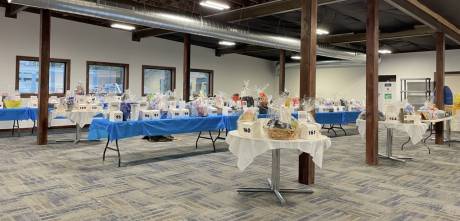
Photos: A large display of baskets are being prepared in the Community Center at The Goose in Oakfield. Photos submitted by Tina Bak.

GLOW YMCA made a tough decision when it opted to sell the rustic Silver Lake Camp Hough more than a year ago, Chief Executive Officer Rob Walker says.
But it has all fallen into place with the purchase by Peter Zeliff Jr. and wife Susan, Walker said. The Zeliff couple plan to offer the nearly 11-acre site to veterans and their families, and have agreed to allow a weekday camp for children during the summer.
“We are so thrilled, absolutely thrilled, that our donors and supporters were so gracious to them. We're very proud that it's going to be used in a way that we hoped it would be used. And that's through the Warrior House, which is another not-for-profit that's going to invest in it,” Walker said Tuesday to The Batavian. “You know, it was a tough decision, but a necessary one for us as an organization. But with that there's a silver lining here and that it's going to stay, more importantly, a children's camp, and it's going to stay with an overnight opportunity for military families. And that's pretty powerful.”
Operational revenue losses, coupled with a COVID-19 pandemic shutdown, created a financial gap that YMCA officials had to address, he said. After conducting some studies, GLOW YMCA partnered with Greater Buffalo Niagara’s branch to provide another option for kids wanting a full resident camp experience, he said. That will be available at Camp Weona in Wyoming County.
“As a whole, the industry really struggled, especially, like I mentioned, after COVID. It's just been a slow kind of decline,” he said, explaining Camp Hough’s new role. “Importantly, too, in addition, because of (the Zeliffs’) perspective and joint respect and cooperation in this, making sure the asset is used in the best possible way, they are allowing us to run a YMCA summer day camp on the property.”
Even though YMCA is no longer the owner, the nonprofit, in partnership with the Village of Perry, will run day programs Monday through Friday at the Silver Lake campground as of June 27, he said.
The proceeds from the Camp Hough sale will be reinvested into the Batavia-based YMCA’s expansion and work at the Healthy Living campus, he said. Abatement has begun, evidenced by construction flags, with ongoing demolition at Cary Hall.
“They're in the final stages of asbestos removal. They're taking that stuff out,” Walker said. “They've been working at that for about a month. And that's expected to come down next month.”
The Batavian will provide more details about the YMCA project in the near future. Meanwhile, the Zeliffs plan to offer the Camp Hough property, with 480 feet of waterfront, to veterans and their families as a camping retreat. Mrs. Zeliff did not return a call made to her for additional comments as of Tuesday evening.
For more information about Warrior House, go to http://www.warriorhouseofwny.com or see the related article here.
2014 File Photo of Camp Hough.
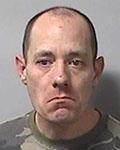
In Genesee County Court today, Matthew T. Zakrzewski faced the metaphorical equivalent of Door 1, Door 2, or Door 3.
Only Door 1 was already open. It contained a maximum prison term on his arson charges of 10 years.
Behind Door 2 is the possibility of 20 years in prison, and behind Door 3 is a jury trial and a possible 40-year prison term if convicted.
Zakrzewski rejected Door 1 because he had done his own research and apparently believes he can beat the five possible felony charges pending against him.
While Zakrzewski's case has not yet been presented to a Grand Jury, he is currently charged with:
District Attorney Kevin Finnell communicated to Zakrzewski's attorney, Fred Rarick, a plea offer that would have Zakrzewski admit to two arson felonies in exchange for a sentence cap of 10 years in prison.
Initially, Zakrzewski accepted the plea offer but after "doing his own research," Rarick told Judge Melissa Cianfrini, Zakrzewski decided there were defenses available to him that might help him beat the charges at trial.
For example, Rarick said Zakrzewski believes he can claim he was drunk at the time of at least one of the crimes and use that as a valid defense.
Rarick said he regrets that there is no way, while Zakrzewski is in the Genesee County Jail, that the attorney could show him video the prosecution could present that purportedly shows Zakrzewski in the act of committing a crime. In his professional opinion, Rarick said, it would be hard to convince a jury, based on that evidence, that Zakrzewski was intoxicated. He isn't stumbling around or displaying other signs of clear inebriation.
In court on Tuesday, Finnell said that if Zakrzewski did not accept the pending plea offer by the end of the hearing, it would be withdrawn, and the cases against him would be presented to a Grand Jury. If indicted, the best plea offer Zakrzewski could hope for was a 20-year prison term. If that was rejected, Finnell noted, and Zakrzewski was convicted at trial, he would face a maximum prison term of 40 years.
Zakrzewski told Cianfrini that he understood the offer and the consequences of rejecting it.
He also said that, based on Rarick's apparent belief that Zakrzewski would be convicted of the charges, he wanted a new attorney.
Cianfrini explained to Zakrzewski in multiple ways that the court had no authority to force the D.A. to reinstate a rejected plea offer, and that once it was withdrawn, it was entirely at the descretion of the District Attorney to decide what, if any, other plea offer might be made.
"It will be out of the court's hands," Cianfrini said. "It is on the District Attorney's authority. The court cannot compel the District Attorney to make a plea offer."
Zakrzewski said he understood that.
She also explained that Rarick had a law degree and passed the bar.
"He has many years of criminal defense experience," Cianfrini said. "His job is to make an assessment of the case based on his training and experience and offer you advice."
"Do you have a law degree?" she asked Zakrzewski.
"No," he said.
Cianfrini told the defendant, "You don't have the background or the training and experience, but it is absolutely your decision." She wasn't trying to influence his decision, she said, but wanted only to make it clear the limits of the court's authority and that once the decision was made, it couldn't be undone.
"His job is to look at the evidence and advise you," she said. "When he tells you things, he's not working against you. He's telling you based on his experience and training, this is what he thinks."
Rarick said that while in his professional opinion Zakrzewski should accept the plea offer, he was ready and willing to assist Zakrzewski in pursuing his right to challenge evidence, make motions, and mount a defense.
After the discussion, Zakrzewski agreed, at least for the time being, to keep Rarick as his attorney.
The 42-year-old Zakrzewski is accused of setting a chair on fire at Washington Towers in mid-January. Later in January, he was accused of starting a fire at a residence on Bank Street earlier in the month. He was later arrested in connection with a reported mid-January fire, also on Bank Street.
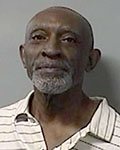
A Batavia man facing a manslaughter charge for allegedly letting the mother of his children die of a drug overdose entered a not-guilty plea in County Court on Monday.
Makeen Ithna-Asheri, 61, is accused of buying drugs for Anda Ithna-Asheri, 61, and then when she overdosed, he allegedly failed to provide aid.
Police were called to the Ithna-Asheri residence at Northside Meadows at 9:32 p.m., Dec. 31, to investigate a report that two adults had overdosed in the presence of their children.
When patrols arrived, Anda Ithna-Asheri was already dead. Emergency responders administered several doses of Narcan to revive Makeen Ithna-Asheri, according to police.
The children were reported to be aged seven and 10.
Last week, Ithna-Asheri was indicated by a Genesee County Grand Jury on counts of manslaughter in the second degree, two counts of endangering the welfare of a child, and criminal possession of a controlled substance 7th.
Ithna-Asheri entered a not-guilty plea to all charges.
Motions in the case are set to be argued at 1:45 p.m. Aug. 9 in Genesee County Court.
Judge Melissa Cianfrini continued Ithna-Asheri's confinement status at $50k bail, $100k bond, and $150k partially secured bond. Still in jail on the same bail.
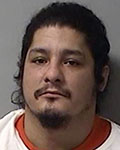
A Basom resident admitted in County Court on Monday that he stole a vehicle and assaulted a police officer in exchange for a potential prison term of no more than seven years.
Justice C. Coniglio, 31, of Basom, entered guilty pleas to grand larceny 3rd for stealing a 2013 Chrysler 2000 and assault 2nd in connection with an incident at his home on Bloomingdale Road, Basom.
His plea deal caps his sentence at 1 1/3 to three years on the grand larceny conviction and 3 1/2 to seven years on the assault conviction, with the sentences to run concurrently.
The plea satisfied pending charges of resisting arrest and obstruction of governmental administration.
Coniglio was arrested on April 25 on the grand larceny charge and on July 23 on the assault charge.
The assault charge seemed to stem from an incident that also involved Jarrett C. Coniglio. Jarrett hit a neighbor, while on the neighbor's property, over the head with a beer bottle and then was involved in the fight with deputies that led to one of the deputies being bit by K-9 "Frankie." The deputy suffered a puncture wound.
Last week, Jarrett was sentenced to five years in prison.
Justice Coniglio will be sentenced at 1:30 p.m. Aug. 30. In the meantime, Judge Melissa Cianfrini ordered that he remain held in the Genesee County Jail on $20,000 bail, $40,000 bond, or $60,000 partially secured bond.
Press Release:
Kiwanis Club of Batavia will be hosting its annual Independence Day 5K on Monday, July 4 at 9 AM at Centennial Park. The club is so excited to bring this event back in person after hosting a virtual event last year.
You can register here
Proceeds from the race will be distributed to the Autism Nature Trail at Letchworth State Park, Batavia City School Foundation for the Community Schools Program, and lastly the Kiwanis activity fund which supports community events such as our Easter Egg Hunt, Thanksgiving Morning Skate and others.
We can’t wait to see you there!
A two-car motor vehicle accident is reported in the area of 986 Bloomingdale Road, Basom.
There are fluids leaking and one person has a possible leg injury.
Alabama Fire and Mercy EMS dispatched.
UPDATE 3:28 p.m.: Pembroke and Indian Falls dispatched mutual aid.
UPDATE 3:30 p.m.: Minor injuries. Responding units can continue non-emergency.

Press Release:
The Batavia Police Department is looking for help in identifying a person of interest in a larceny at Tops Supermarket which occurred on June 2 at approximately 10:05 a.m. Anyone with information on the identity of the person in the photo is asked to contact Officer Christopher Lindsay at 585-345-6350, the confidential tip line at 585-345-6370. Please do not post tips on Facebook or Twitter as the posts are not continuously monitored.

The Batavia Muckdogs (3-1) plated an eight-inning run to break a 5-5 tie with the Auburn Doubledays at Dwyer Stadium on Monday in a game that was delayed a couple of times due to rain.
In the eighth, Brian Fry doubled to open the frame, advancing later in the inning on a double steal after Daniel Burroway had reached base on an error. Fry scored on a sacrifice fly from Alec Maag.
Fry was named player of the game after going 4-4, scoring twice and knocking in a run. The sophomore at the University of Toledo and from Medina is now hitting .533 on the season.
Tyler Cannoe had a hit and two RBIs and Burroway had two RBIs.
The winning pitcher was Trey Bacon. The Santa Fe College sophomore started in left field but took the mound in the seventh inning and gave up only one hit, striking out four, over three innings.
Joshua Milleville, from Lockport and attending Fairleigh Dickinson University, made his first start of the season. Milleville escaped a tough spot in the opening frame. He hit two hit batters, gave up a single and a sacrifice fly to score one run before he recorded his first out. He only gave up one more run in 3 2/3 innings of work, striking out three while surrendering seven hits. Batavia's Alex Hale came on in relief and gave up four hits, two runs and walked two over 2 1/3 innings.
Eddie Rives took the loss for Auburn.
Top photo: Brian Fry with a stolen base in the first inning.
Photos by Howard Owens

Auburn shortstop Cooper Erickson scores the first run of the game in the first inning while Batavia catcher Alec Maag waves off a throw to the plate.

Third baseman Jerry Reinhart.

Fry singles in the first inning.

Starting pitcher Joshua Milleville

Second baseman Fry fielding a ground in the first.

Jerry Reinhart fouls off a pitch in the second inning.

Josh Leadem, attending the University of Rochester, grounds out to third in the second inning.

Extra hitter Liam Ward, from Albion and attending Niagara University, fouls off a pitch in the second inning.

Reinhart, Caleb Rodriguez, and Fry during the National Anthem.
Copyright © 2008-2022 The Batavian. All Rights Reserved. Privacy Policy | Terms of Service